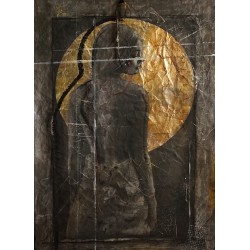ĆWIKŁA EWA
The photographs of EWA ĆWIKŁA, a Pole whose second homeland is the Netherlands, have something disturbing, dark, baroque in them. They are unusual, capricious, far removed from the expectations associated with today's portrait photography. Her models as well as the compositions of the photographs are clearly and almost completely determined by the dialogue with art of the Dutch and Flemish Golden Age. These extraordinary, stunning effects derive from what is technically known as "Caravaggio light" or "Rembrandt light". Her images are inspired by her genuine admiration and understanding of this trend in painting as well as of the atmosphere of the 17th century Netherlands, which she absorbed while visiting Dutch museum collections and cities permeated for centuries by the spirit of the great masters. The photographs of Ewa Cwikła are distinguished by the perfection of the studio arrangement, the astonishing perspective on a human being as a painterly form, an almost mathematical precision in setting the artificial light, which is focused on a chosen motive and scattered elsewhere, flowing from several sources. Despite this strenuous studio artistry, from characterizing the model to the dialogue of various types of lighting she employs, her master portraits have no pathos nor artificiality, exaggerated gesture nor false facial expressions.
I like diversity, discovering, experimenting, but I always come back to the theme of portrait. People are central in my photography.
I often meet my male models, but most of all female models (both adults and teenagers) by accident, sometimes noticing them in the crowd on the street. I invite them to a photo session and slowly discover the incredible power hidden in their faces, gestures, body dynamics. I fall in love with my model as a human being and in return, I get the same - the closeness. It is wonderful to work with them.
I think that photography is a highly intimate part of my life. When I take photographs, I open myself to the world and give it my best.One of my favorite models is a fifteen-year-old by the name of Fleur, full of grace and power that radiates. Her warm, fiery-red hair and freckled face, her pupils staring mistily from under her parted and slightly swollen eyelids, her lips arranged in the grimace of a small rebellious princess, together constitute an image that profoundly shakes and permeates us. Fleur, like other models, poses in different outfits that draw on the fashion from centuries ago, but not only the fashion. The images draw perfectly on the aesthetics of the Holland of old time, are immersed in its mood and in the honey-coloured or pearly blue light loved by the painters of those years.
When taking photos, or editing, I am not really concerned with putting ideas in the viewer's mind. I am more concerned with the feeling that I have. Very often I look for the feeling of my childhood in pictures, the emotions, sometimes even the smell. I know it is absurd, but I can visualize and remember so strongly that it is very normal for me.
Sometimes,I start with an idea in mind: a moment of daily life, the ray of light, or a word during a conversation are reasons for me to create a new image. The gestures or comments of my models also play a major role here. It is a paranormal thing that I cannot explain.
I admire Erwin Olaf's strength in experimenting and searching for the new "me. I am tired of searching and experimenting,I am angry that I cannot stay on a quiet road and make all portraits with the same montage and style, but then comes my rescuer. I see Olaf’s book on my bookshelf, and I know it is okay. With him, there is something different on every page. I admire this a lot.
I learned everything myself. I have never been to workshops, nor learned from another photographer. I gave a workshop to photographers who now have great careers; I am so proud of them.
I shoot mostly with a Nikon 850Dand an 85mm 1:4 lens. I have more lenses from Nikon, Zeis, Sigma, but I use them sporadically. You can also find my old Nikon D8oo and Sony Alfa 7III in my camera bag. I use a Sony camera for landscape. I increasingly use analog lenses to create a more vintage effect in my portraits. In terms of postproduction, I work with Photoshop. I am using the Nik Collection plugin. I also experiment, but always work with the light that I made during a session in the studio.
I am a creative photographer. Most ideas are born during the photoshoots, even if I had come up with something beforehand. When I work with new models, my sessions are the most creative, and I really like that. Sometimes a gesture from a model is a reason for me to create a new scene.



